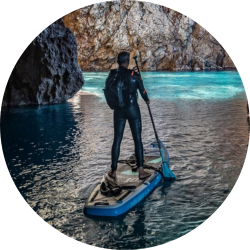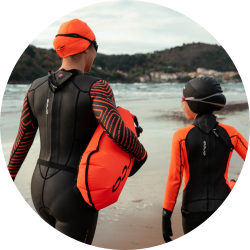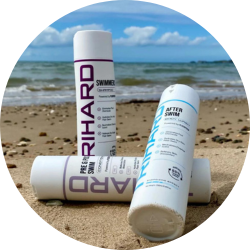Summary:
- 1. Rediscover the Joy of Exercise
- 2. A Boost for Mind and Body
- 3. A Social and Supportive Community
- 4. Adventure and Thrill
- 5. Conquer New Challenges
Introduction: Dive Into the World of Open Water Swimming
Do you ever feel like your regular workout routine has become monotonous? Are you looking for a new and exhilarating way to stay fit while connecting with nature? If you answered yes, then open water swimming might just be the perfect activity for you! Imagine immersing yourself in the refreshing embrace of natural water, feeling the sun on your face, and experiencing the freedom of swimming without the confines of a pool. In this article, we will explore five compelling reasons why you should give open water swimming a try. So, grab your goggles and dive into the world of open water swimming!
1. Rediscover the Joy of Exercise
Break Free from the Monotony
Are you tired of staring at the same pool tiles every time you swim? Open water swimming offers a refreshing change of scenery that can reignite your passion for exercise. Say goodbye to the repetitive nature of pool laps and hello to exploring vast lakes, rivers, or even the ocean. The ever-changing landscape will keep you engaged, providing new challenges and motivating you to push yourself further.
A Natural Playground
Unlike the controlled environment of a pool, open water presents a natural playground for swimmers. As you glide through the water, you'll encounter various elements such as waves, currents, and wildlife. These dynamic factors make each swim a unique adventure, stimulating your senses and sharpening your swimming skills. You'll learn to adapt to different conditions, improving your overall strength and endurance.
Engage with Nature
Open water swimming provides a rare opportunity to connect with nature in a profound way. As you swim alongside fish, plants, and other aquatic creatures, you'll gain a newfound appreciation for the ecosystem that exists beneath the water's surface. Imagine the exhilaration of swimming in crystal-clear waters, feeling at one with the environment around you. It's an experience that brings a sense of tranquility and peace, leaving you refreshed and invigorated.
2. A Boost for Mind and Body
Dive into Serenity
Have you ever noticed how water has a calming effect on the mind? Open water swimming takes this to a whole new level. Submerging yourself in natural bodies of water can have a profound impact on your mental well-being. The soothing rhythm of your strokes, combined with the serene surroundings, creates a meditative experience that washes away stress and anxiety. It's an opportunity to disconnect from the noise of daily life and find inner peace beneath the surface.
Embrace the Elements
Swimming in open water means encountering a range of weather conditions. While this might sound daunting, it presents an opportunity to embrace the elements and challenge yourself in ways you never thought possible. Whether it's swimming against the current, navigating through waves, or feeling the coolness of raindrops on your skin, you'll develop resilience and mental fortitude. These skills will not only benefit you in the water but also in other aspects of your life.
3. A Social and Supportive Community
Bond with Like-minded Individuals
Open water swimming has a way of bringing people together. It fosters a strong sense of camaraderie among swimmers, as they share the same passion for this unique activity. Whether you participate in organized events or join local swimming groups, you'll have the opportunity to bond with like-minded individuals who understand and appreciate the joy of open water swimming. It's a chance to form lasting friendships and create memories that will last a lifetime.
A Supportive Network
The open water swimming community is known for its inclusivity and support. Whether you're a beginner or a seasoned swimmer, you'll find encouragement and guidance from fellow enthusiasts. Swimmers often share tips, training advice, and stories of their own experiences, creating a supportive network that celebrates each other's achievements. Being part of such a community not only enhances your swimming journey but also provides a source of motivation and inspiration.
4. Adventure and Thrill
Unleash Your Inner Adventurer
Open water swimming is an invitation to embrace your adventurous spirit. It opens doors to exploration and discovery, allowing you to venture into uncharted waters. From exploring hidden coves and secret lagoons to swimming across vast lakes or along picturesque coastlines, every swim becomes an exciting adventure. The thrill of the unknown and the anticipation of what lies ahead will awaken your inner adventurer and fill you with a sense of awe and wonder.
5. Conquer New Challenges
In open water swimming, you'll encounter various challenges that push you beyond your comfort zone. Whether it's overcoming fears of deep water, navigating through unfamiliar currents, or conquering long-distance swims, each challenge you conquer will boost your confidence and resilience. Open water swimming teaches you to embrace the unknown, face obstacles head-on, and emerge stronger on the other side. It's a powerful metaphor for life itself.
How to Get Started
Gear Up
Before you dive into open water swimming, it's essential to have the right gear. Invest in a comfortable and well-fitting wetsuit for swimming that provides insulation and buoyancy. Open Water Swimming Goggles with tinted or polarized lenses will protect your eyes from the sun's glare, while a brightly colored swim cap enhances visibility for safety. Additionally, consider using a swim buoy, which not only keeps you visible but also provides a flotation device if needed.
Safety First
Safety should always be a top priority when engaging in open water swimming. Swim in designated areas with lifeguards present, if possible. Familiarize yourself with the swim route and be aware of potential hazards such as rocks, strong currents, or marine life. It's also a good idea to swim with a buddy or join a local swimming group for added safety and support.
Build Your Skills
If you're new to open water swimming, it's wise to gradually build your skills and confidence. Start by practicing in calm and controlled environments such as lakes or protected bays. As you become more comfortable, gradually introduce yourself to different conditions, such as swimming in choppy waters or navigating through currents. Consider taking swimming lessons or seeking guidance from experienced open water swimmers to improve your technique and ensure a safe and enjoyable experience.
Conclusion: Dive In and Discover the Wonders of Open Water Swimming
Open water swimming offers a myriad of benefits that extend beyond mere exercise. It's a chance to break free from the monotony, engage with nature, boost your mind and body, connect with a supportive community, and embark on thrilling adventures. So, why not take the plunge and give open water swimming a try? Discover the wonders that await you beneath the surface, embrace the challenges, and immerse yourself in the beauty of the natural world. Grab your swimsuit, gather your courage, and dive into the extraordinary realm of open water swimming. The possibilities are endless, and the experiences will leave you with a sense of awe and accomplishment. Are you ready to make a splash?
































































































Validate your login